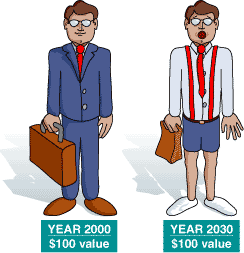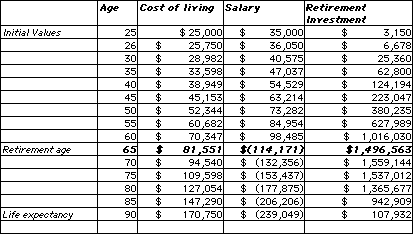
HOT TOPICS LIST
- Strategies
- Stocks
- Buy
- Investing
- Brokers
- Psychology
- Interviews
- Accumulate
- Sell
- Hold
- Spotlight
- Websites
- Candlestick Corner
- Gold & Metals
- Options Trading
LIST OF TOPICS
PRINT THIS ARTICLE
by Han Kim
It's your money- how are you going to put it to work?
Han Kim
Staff Writer
PRINT THIS ARTICLE
RETIREMENT PLANNING
Planning Your Retirement
09/10/00 07:59:27 PM PSTby Han Kim
It's your money- how are you going to put it to work?
| Unless you run for public office yourself, you really don't have control over your government-aided retirement income. We've all heard that Social Security is underfunded, and at its current rate may be non-existent by the time you retire. With that in mind, the amount you need to save and how to do it are two questions that need to be addressed right now. Given that no one can predict the future (or that predictions into the future are only proven correct in retrospect), you should project what the cost of living will be at the time of your retirement. Take a look at the hypothetical cost of living in 2030. Assuming average inflation increases by 3% (which has been the average inflation rate for the last 10 years), a nice pair of slacks that costs $100 in today's dollars will cost you about $240 in 2030. That means $100 in 2030 will leave you feeling a little short-changed in the future. You will need to be making about two and a half times your current salary in 2030 just to have the same standard of living that you do now. So thinking about your retirement in today's dollars will not take into account future inflationary costs of living, and your future finances need go up to, and include, your retirement years.  FIGURE 1: NEW STYLE OR JUST UNDRESSED? Here's a representation of the value of your money in the not-so-distant future. If you're expecting to dress yourself in pretty much the same way in 2030 as you are in 2000, you may be in for a surprise. |
| Some factors you need to consider when determining your living expenses are: Your life expectancy and the inflation rate are generally figured to be 90 years and 3% respectively. If you like, you can change these estimates and make them higher or lower to find a range of possible living expenses (See sidebar Planning Your Retirement Income Using Excel). Let's look at a simplified example. Figure 2 represents the money you save and the amount of money you will have when you retire. There are two major assumptions in this calculation: first, your investment has a 9% return every year compounded annually, and second, inflation and your salary will increase at a rate of 3% annually. For simplicity's sake, as in who knows what the government will do with taxation rates, tax is not considered. |

|
| FIGURE 2: SAVING. Here’s a representation of the retirement capital of an individual who starts to save at age 25, assuming a $35,000 annual income, and the resulting value of his or her investment at three different rates. |
| |
| Let's say that you are 25 today (in that case, happy birthday!) and your salary is $35,000. You are planning to retire at 65 and expect to live to 90, but also considering earlier retirement if possible. With that in mind, how much should you invest for your retirement? You have the option of saving 7% every year with ease, 9% without too much thought, and 15% with a little effort. The choice you make can be the difference between enjoying your retirement and having to go back to work when you're 80. How do you figure? Take a look at Figure 2. If you were to invest 7% of your salary until you retired at 65 (that's the red line), you would have gathered about $1.15 million for your nest egg. You continue to live at the same standard of living that you were prior to your retirement, but due to the increase in the cost of living, your withdrawals from your retirement investment slowly increase. At this pace, you will have spent all of your retirement investment by the time you turn 80. Do you go back to work at this stage of your life? Just a little adjustment to your investments can completely change that scenario. By investing 2% more each year (9% annually; see the green line), the value of your nest egg at 65 is close to $1.5 million and peaks at about $1.63 million when you are 72. Instead of going back to work at 80, you can enjoy your golden years to their full extent and still have about $100,000 left over. But if it's early retirement you want, then you'll have to invest a bit more. By investing 15% annually (see the blue line), you will be able to retire on your 59th birthday and still be a millionaire at 90. As you can see from Figure 2, your money starts to increase exponentially in the later years of your working career. This is where you can make the most from your compounding interest. The longer you wait to retire, the bigger your nest egg. Just investing a little more each year could make a huge difference for your golden years. So what's it going to be? |
Sidebar: Planning Your Retirement Income Using Excel |
Staff Writer
| Title: | Webmaster |
| Company: | Technical Analysis, Inc. |
| Address: | 4757 California AVE SW |
| Seattle, WA 98116 | |
| Phone # for sales: | 206-938-0570 |
| Fax: | 206-938-1307 |
| Website: | working-money.com |
| E-mail address: | hkim@traders.com |
Traders' Resource Links | |
| Charting the Stock Market: The Wyckoff Method -- Books | |
| Working-Money.com -- Online Trading Services | |
| Traders.com Advantage -- Online Trading Services | |
| Technical Analysis of Stocks & Commodities -- Publications and Newsletters | |
| Working Money, at Working-Money.com -- Publications and Newsletters | |
| Traders.com Advantage -- Publications and Newsletters | |
| Professional Traders Starter Kit -- Software | |
PRINT THIS ARTICLE

|

Request Information From Our Sponsors
- StockCharts.com, Inc.
- Candle Patterns
- Candlestick Charting Explained
- Intermarket Technical Analysis
- John Murphy on Chart Analysis
- John Murphy's Chart Pattern Recognition
- John Murphy's Market Message
- MurphyExplainsMarketAnalysis-Intermarket Analysis
- MurphyExplainsMarketAnalysis-Visual Analysis
- StockCharts.com
- Technical Analysis of the Financial Markets
- The Visual Investor
- VectorVest, Inc.
- Executive Premier Workshop
- One-Day Options Course
- OptionsPro
- Retirement Income Workshop
- Sure-Fire Trading Systems (VectorVest, Inc.)
- Trading as a Business Workshop
- VectorVest 7 EOD
- VectorVest 7 RealTime/IntraDay
- VectorVest AutoTester
- VectorVest Educational Services
- VectorVest OnLine
- VectorVest Options Analyzer
- VectorVest ProGraphics v6.0
- VectorVest ProTrader 7
- VectorVest RealTime Derby Tool
- VectorVest Simulator
- VectorVest Variator
- VectorVest Watchdog
